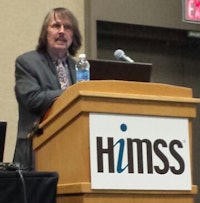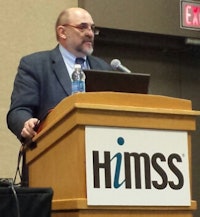
ORLANDO, FL - When the Cleveland Clinic moved to a vendor-neutral archive (VNA), it realized a wide range of advantages, not the least of which was improved access to images -- radiology and nonradiology -- through the electronic medical record (EMR), according to a presentation on Monday at the Healthcare Information and Management Systems Society (HIMSS) meeting.
After adopting a VNA to facilitate the storage and access of data from both radiology and nonradiology applications, the Cleveland Clinic experienced benefits such as improved information sharing, greater operational efficiency, and significant cost savings, according to Louis Lannum and Dean Balog.
"Every image captured today, regardless of [the] department or service line, is accessible in the EMR," Lannum said.
The Cleveland Clinic Imaging Institute's decision to move from a vendor-specific PACS to a VNA (Agfa HealthCare) opened up the opportunity to decouple image storage and access from department systems, Balog said. This change brought the potential to expand enterprise viewing capability for images from other departments.
"The VNA gave us the ability to bring this all into one spot, and expand that [access] through a common viewer," Balog said.
To accomplish this goal, an enterprise imaging department was created within the IT department in 2011. In addition, an imaging council was formed as a subset of the IT department's physician advisory group.
 Dean Balog from the Cleveland Clinic.
Dean Balog from the Cleveland Clinic.
Part of the enterprise imaging support model was to provide centralized support for image management systems in individual departments. At the same time, those images were brought into the central archive to be accessible through the enterprise viewer, Balog said.
Cruder integrations of radiology image viewing within the EMR had previously been accomplished and were well-received; however, the expansion of available images had been requested for several years, according to Balog.
"The new viewer that we brought in was a much more sophisticated integration with the electronic medical record," he said. "Being a Web-based viewer, it basically appears as a window of the EMR and looks like it's part of that system. To the common user, it's just part of the EMR, not a separate system."
First, though, a promotional effort had to be undertaken to demonstrate the value of having medical images integrated in the EMR, he said. A number of outreach efforts were made, including participating in staff meetings and making announcements on the main intranet home page, regional hospital home pages, and physician-specific home pages. There were also announcements in staff, institute, and department newsletters.
As radiology image viewing was well-established, the project initially focused on replacing links to the old viewer in the EMR. The group took a staged approach based on geography, working across the main campus and then moving out to the community hospitals.
Once the new system was in place and accepted by the client community for radiology image viewing, the institution began adding nonradiology images. Ultrasound images from the women's health department were added, followed by images from the digestive disease department and others, Balog said.
Beyond radiology
While radiology was the driving force for the VNA, there is a much more practical use for the archive across the enterprise, Lannum said.
"We developed a program whose basic strategy is to ensure that every department and every service line that captures an image sends the images to the library," he said. "The library is not a storage container; the library is a DICOM library. Everything that's sent to that library matches a scheduled event or order in the EMR."
The VNA serves as an extension of the EMR. "Nothing goes into that library unless it's normalized to the EMR," he said.
There are 60 image-generating departments at the Cleveland Clinic. In 2013 -- the first year of the program -- 175,000 nonradiology and noncardiology images were sent to the VNA, according to Lannum.
"We're expecting well over 250,000 images [in 2014] as the program continues to move," he said.
Know your images
It's important to understand where images are being generated at your institution, Lannum said.
 Louis Lannum.
Louis Lannum.
"Every doctor coming out of medical school is not going to get a stethoscope anymore, they're going to get a portable ultrasound," he said. "That image has to go someplace. If a physician captures a photograph [or] if a physician does a point-of-care ultrasound, if there is a reference to that photograph or that ultrasound in the medical record, I think we are responsible for also capturing and making that image available as part of the continuity of care."
With a workflow engine that utilizes HL7 admission, discharge, and transfer (ADT) information in the EMR, the group has created mechanisms for incorporating point-of-care imaging such as ultrasound and digital photos. For example, in dermatology, a photographer selects the patient and procedure from a worklist, loads images into the image capture application, and matches the photo with the patient. After the images are "DICOM-ized" and checked for errors, they are available later as a DICOM image in the EMR.
In radiology, a VNA offered the promise of avoiding future data migrations when switching to a new PACS vendor.
"What we've ended up doing is taking that story and attaching the image access management piece to it, so that no longer is radiology responsible for distributing those images," Lannum said. "They're responsible for taking those images and putting them into the storage container. The enterprise viewer is attached to the storage container, so now radiology becomes just another specialty department feeding data into a centralized repository that I now have access to in an EMR."
A strategy was developed to take images from all departments into a management service layer and make them part of the library, he said. For departments without an image management system, the workflow service offers a means of associating an image with a scheduled event in the EMR.
Many benefits
The system has yielded benefits such as improved information sharing among all providers along the continuum of care. It also reduces subjective interpretation of written findings and combines visual and narrative information to create a more comprehensive patient record, Balog said.
In addition, the system facilitates the creation of a longitudinal imaging history within the context of the patient's EMR by serving as a single point of integration between the EMR and images. The approach collapses multiple silos into a single imaging storage and access solution, he said.
It's also useful for patient education -- visually engaging them in the diagnosis and treatment process. Images can be reviewed with patients to enhance understanding of their conditions and treatment plans, Balog said.
Cost savings have also been realized in both infrastructure and support, with reductions in the amount of money spent within the individual department silos. There has also been cost and risk avoidance from managing a HIPAA-compliant storage solution.
For example, unified management and integration of intraoperative images in the institution's sports health department produced lower printing-related costs, with an estimated savings of $18,000 a year for five rooms, Balog said.
Increased operational efficiency by eliminating image scanning saves an estimated $75,000 in labor costs per year. Patient demographics are also automatically populated during room setup, saving an average of 38 seconds per case.
"The Cleveland Clinic has 225 [operating rooms], so overall that saves a lot of time," Balog said.



















